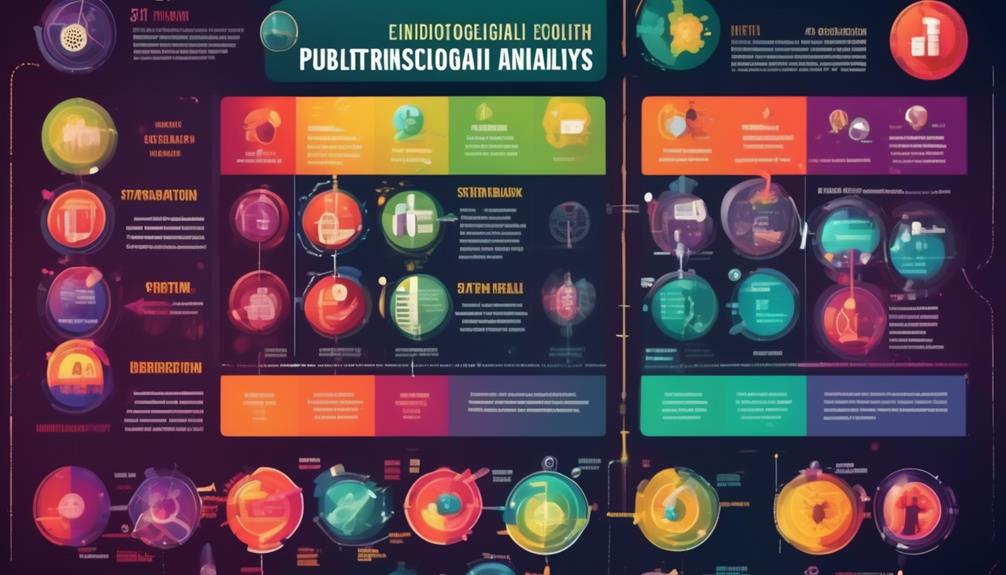Navigating today's complex world highlights the intersection of individual health and the well-being of entire populations.
The 6th edition of 'Introduction to Public Health' provides a comprehensive exploration of essential concepts and practical applications for understanding and addressing public health challenges.
This edition offers key updates, practical case studies, and critical insights tailored for professionals in the field.
It covers epidemiology, health policy, and environmental health, making it a valuable resource for anyone interested in contributing to the field of public health.
Key Updates in 6th Edition
In the 6th edition of Introduction to Public Health, we've made important updates to incorporate the latest evidence-based practices and emerging public health challenges.
One significant update in this edition focuses on the current trends in infectious diseases. This includes updated information on epidemiology, prevention strategies, and the impact of diseases like measles and tuberculosis on global public health, given the rise of antimicrobial resistance and the re-emergence of certain infectious diseases.
Another key update addresses the increasing prevalence of non-communicable diseases (NCDs) globally. We've included recent data on the burden of NCDs, along with updated information on risk factors, prevention measures, and the role of public health in addressing these conditions.
Additionally, we've integrated new findings and recommendations related to environmental health, occupational health, and healthcare disparities.
These updates aim to provide readers with the most current and relevant information in the field of public health, ensuring that the 6th edition remains a valuable resource for students, practitioners, and researchers.
Core Concepts Explained
Understanding the fundamental principles of public health is crucial for developing effective interventions and policies. These principles provide a framework for grasping the various factors that influence health outcomes at the population level.
We'll also explore strategies for preventing diseases and promoting the health of communities. By doing so, we aim to improve the overall well-being of populations.
Key Public Health Principles
Understanding key public health principles is crucial for promoting and safeguarding the health of populations. Health disparities, which are variations in health outcomes among different groups, are a vital focus of public health principles. These differences can be influenced by social determinants such as income, education, employment, and access to healthcare.
By addressing these social determinants, public health aims to diminish disparities and enhance overall health outcomes for all individuals.
Moreover, principles such as prevention, health promotion, and community engagement are fundamental to public health practice. Prevention strategies, including vaccinations and screenings, play a crucial role in lessening the burden of disease. Health promotion efforts aim to empower individuals and communities to make healthy choices.
Community engagement fosters collaboration and participation, which are essential for effective public health interventions.
Disease Prevention Strategies
Strategies for preventing diseases involve a range of actions aimed at reducing the occurrence and impact of various illnesses in a population. These strategies often include health education, vaccination programs, and changes to the environment.
Community involvement is crucial for the success of prevention strategies as it builds a sense of ownership and responsibility for health outcomes. By engaging the community in decision-making and implementation, prevention efforts can be more effective and long-lasting.
Health education involves providing information to encourage healthy behaviors, while vaccination programs immunize individuals to prevent specific diseases. Environmental modifications focus on altering the physical environment to reduce disease risk.
Involving the community in the design and implementation of disease prevention strategies fosters a shared responsibility and creates a supportive environment for promoting health.
Population Health Promotion
Population health promotion involves using community-based strategies to improve the overall well-being and health outcomes of a specific group of people, building on efforts to prevent diseases. It includes a wide range of actions to address health disparities and inequalities within populations.
By focusing on population health, we aim to understand and tackle the social, economic, and environmental factors contributing to these disparities. This approach emphasizes the importance of preventive measures, health education, and community involvement to promote long-term health and well-being.
Through targeted initiatives and policies, we strive to create environments that support healthy choices and enable individuals to lead healthier lives. Addressing the root causes of health disparities is crucial in improving the overall health of communities.
Practical Applications and Case Studies
To understand how public health principles work in real-life situations, we'll explore practical applications and case studies that show how public health interventions affect communities.
By looking at real examples, we can gain a better understanding of how public health strategies are put into practice and their impact on the health of the population.
Real-life examples give us insight into the challenges and successes of public health initiatives, providing valuable lessons for future interventions.
Through case study analysis, we can examine the many factors that influence health outcomes within communities, helping us apply theoretical knowledge to real situations and understand the practical implications of public health principles.
By critically examining these real-world scenarios, we can identify effective strategies, potential pitfalls, and areas for improvement in public health practice.
This approach equips us with the knowledge and skills needed to address complex public health challenges and contribute meaningfully to the well-being of populations.
Comprehensive Coverage of Epidemiology

We provide a thorough understanding of epidemiology, laying a strong foundation for comprehending public health issues.
The use of real-life case studies makes the concepts relevant and practical, helping readers apply epidemiological principles to different scenarios.
This exploration enables a deeper grasp of how epidemiology contributes to public health practice.
Epidemiology Basics Covered
This section provides a comprehensive overview of the basics of epidemiology, focusing on the essential principles and methods used to study health and disease patterns in populations.
Data analysis is a key component in epidemiology, as it offers insights into the distribution and determinants of health-related conditions or events. This involves examining and interpreting data to identify trends, risk factors, and potential interventions.
Key topics covered include understanding disease frequency and measures of association, exploring various study designs such as cohort, case-control, and cross-sectional studies, and emphasizing the importance of valid and reliable data collection methods.
Mastering these fundamental epidemiological concepts and data analysis techniques equips public health professionals with the necessary tools to effectively investigate and address health issues at a population level.
Illustrative Case Studies Included
Understanding the basics of epidemiology is crucial for studying health and disease patterns in populations. It's essential to include real-life case studies to demonstrate how epidemiological concepts are applied in practice. These case studies show the practical applications of epidemiology in identifying and addressing public health concerns.
By examining specific instances of disease outbreaks or interventions, readers can better grasp how epidemiological principles are used in real-world scenarios. Additionally, the case studies highlight the effectiveness of disease prevention strategies and the impact of public health initiatives on population health.
Analyzing these cases helps readers appreciate the role of epidemiology in shaping public health policies and interventions, providing a deeper understanding of its significance.
Understanding Health Policy
Understanding health policy requires a deep understanding of how government rules, healthcare systems, and public health goals all interact. Analyzing policies helps us evaluate how effective and fair they are, especially in addressing differences in health outcomes. Here are some important things to consider when it comes to understanding health policy:
- Engaging with Stakeholders: It's crucial to involve a variety of people, like policymakers, healthcare providers, and community members, to create health policies that work for everyone.
- Using Evidence for Decisions: Making policy decisions based on scientific evidence and data analysis ensures that choices are well-informed and lead to better results.
- Prioritizing Fair Health Opportunities: Designing and implementing policies that prioritize fair health opportunities is essential for addressing disparities and ensuring that everyone has a chance for good health.
Looking at health policy through these considerations helps us understand the complex factors affecting public health outcomes. By recognizing how policy, systems, and population health are all connected, we can work towards creating policies that support the well-being of individuals and communities.
Exploring Environmental Health

Studying how environmental factors affect public health provides valuable insights into the connection between our surroundings and well-being. Environmental risk factors like air and water pollution, exposure to harmful chemicals, and climate change have a significant impact on community health. Understanding the link between environmental risk and its impact on communities is crucial for creating effective public health interventions.
These risk factors can lead to a wide range of health problems, including respiratory diseases, cardiovascular issues, and certain types of cancer. For instance, poor air quality in urban areas has been linked to a higher prevalence of asthma and other respiratory conditions among residents. Furthermore, contaminated water sources can cause outbreaks of waterborne illnesses, posing a direct threat to community health. Understanding these connections is essential for protecting community well-being.
Critical Insights for Professionals
Understanding the impact of our environment on community health is crucial for public health professionals. By exploring environmental risk factors, we gain valuable insights that inform effective public health interventions. This helps us recognize the complex interplay between environmental factors and health outcomes.
For instance, collaborating with sectors like urban planning, transportation, and agriculture allows us to comprehensively address environmental health challenges, leading to more sustainable interventions. It's also important to acknowledge the disproportionate burden of environmental risk factors on marginalized communities, which is essential for developing interventions that prioritize health equity and social justice.
Additionally, utilizing data to analyze the association between environmental exposures and health outcomes empowers us to make informed decisions and advocate for evidence-based policies and interventions.
Frequently Asked Questions
Can I Access Additional Online Resources or Study Materials for the 6th Edition of Introduction to Public Health?
Yes, you can access extra online resources and study materials for the 6th edition of Introduction to Public Health. Online forums and discussion groups provide valuable opportunities for sharing insights and learning from others. This additional support can enhance your understanding of the subject, allowing you to engage with different perspectives and deepen your knowledge.
Are There Any Upcoming Workshops or Webinars Related to the Topics Covered in the 6th Edition?
Yes, there are upcoming workshops and webinars covering various public health topics. These opportunities offer access to study materials, online resources, and international references, providing valuable insight into career paths, job opportunities, and global public health initiatives. These events are essential for staying updated and gaining knowledge about the latest developments in public health. By participating in these workshops and webinars, individuals can enhance their understanding and skills, ultimately contributing to the improvement of public health on a global scale.
How Has the Field of Public Health Evolved Since the 5th Edition Was Published?
Since the 5th edition, public health practices have evolved significantly. Research findings have driven global impact, expanding the field's reach. It's impressive to see how the field has continued to grow and adapt to new challenges.
Are There Any Specific Career Paths or Job Opportunities That Are Highlighted in the 6th Edition?
The 6th edition highlights specific career paths and job opportunities in various sectors of public health, providing valuable insights for those interested in entering the field. It sheds light on promising employment prospects, offering clear guidance for individuals seeking to pursue a career in public health. This edition simplifies the language and avoids overused phrases to ensure a clear and straightforward presentation of the available career paths and opportunities. It is important for readers to understand the significance of these highlighted opportunities and how they can benefit from the insights provided. By using a natural flow and active voice, the content aims to engage the audience and provide comprehensive details about the career paths and job opportunities in public health. This approach ensures that the information is easily accessible and comprehensible to readers with varying levels of familiarity and knowledge in the field.
Can the 6th Edition Be Used as a Reference for Students Studying Public Health in Countries Outside of the United States?
Yes, the 6th edition is suitable for students studying public health outside the US as it provides a global perspective, aligns with different curricula, and offers cultural relevance. This edition is valuable for broadening students' understanding and ensuring international applicability in the field of public health.
Conclusion
The 6th edition of Introduction to Public Health serves as a valuable guide through the complex world of public health. It provides updated content, practical applications, and comprehensive coverage of key concepts, offering professionals critical insights essential for addressing the challenges of public health practice.
This edition is a valuable resource for gaining a deeper understanding of epidemiology, health policy, and environmental health.







No Comments